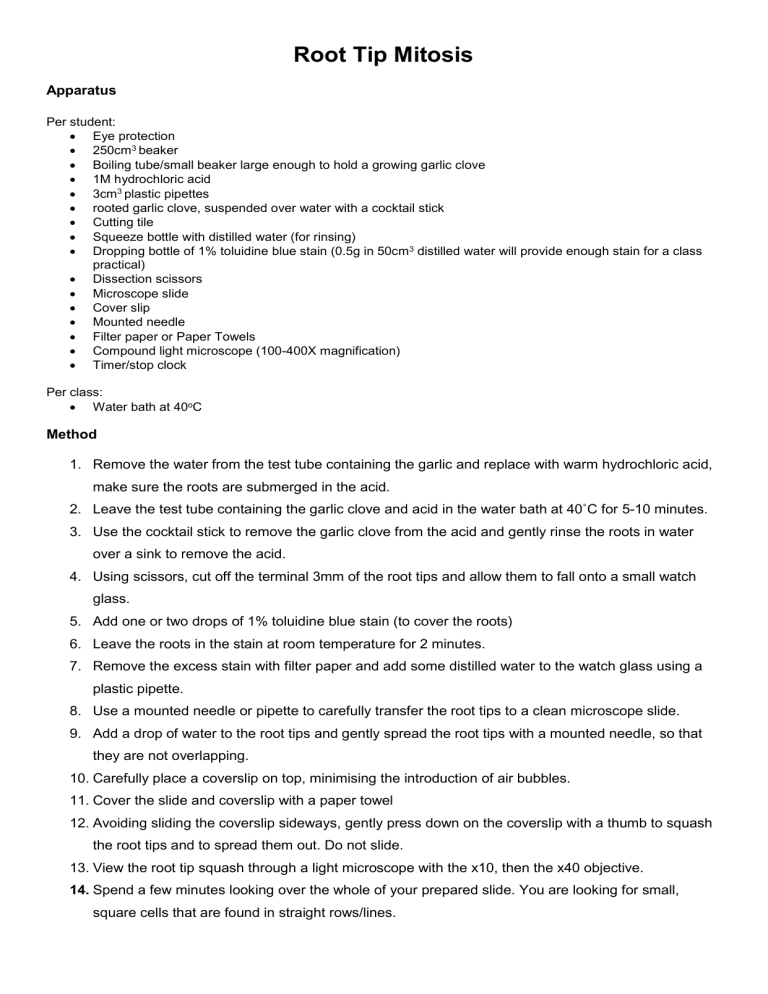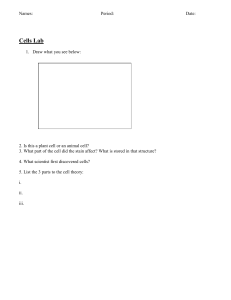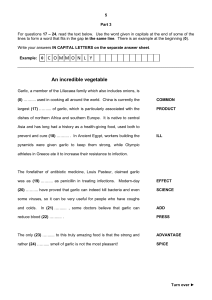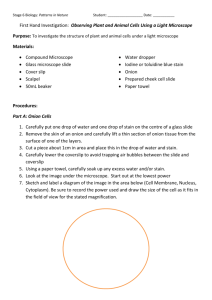
Root Tip Mitosis Apparatus Per student: Eye protection 250cm3 beaker Boiling tube/small beaker large enough to hold a growing garlic clove 1M hydrochloric acid 3cm3 plastic pipettes rooted garlic clove, suspended over water with a cocktail stick Cutting tile Squeeze bottle with distilled water (for rinsing) Dropping bottle of 1% toluidine blue stain (0.5g in 50cm3 distilled water will provide enough stain for a class practical) Dissection scissors Microscope slide Cover slip Mounted needle Filter paper or Paper Towels Compound light microscope (100-400X magnification) Timer/stop clock Per class: Water bath at 40oC Method 1. Remove the water from the test tube containing the garlic and replace with warm hydrochloric acid, make sure the roots are submerged in the acid. 2. Leave the test tube containing the garlic clove and acid in the water bath at 40˚C for 5-10 minutes. 3. Use the cocktail stick to remove the garlic clove from the acid and gently rinse the roots in water over a sink to remove the acid. 4. Using scissors, cut off the terminal 3mm of the root tips and allow them to fall onto a small watch glass. 5. Add one or two drops of 1% toluidine blue stain (to cover the roots) 6. Leave the roots in the stain at room temperature for 2 minutes. 7. Remove the excess stain with filter paper and add some distilled water to the watch glass using a plastic pipette. 8. Use a mounted needle or pipette to carefully transfer the root tips to a clean microscope slide. 9. Add a drop of water to the root tips and gently spread the root tips with a mounted needle, so that they are not overlapping. 10. Carefully place a coverslip on top, minimising the introduction of air bubbles. 11. Cover the slide and coverslip with a paper towel 12. Avoiding sliding the coverslip sideways, gently press down on the coverslip with a thumb to squash the root tips and to spread them out. Do not slide. 13. View the root tip squash through a light microscope with the x10, then the x40 objective. 14. Spend a few minutes looking over the whole of your prepared slide. You are looking for small, square cells that are found in straight rows/lines. Notes The garlic clove can be suspended over water, using a cocktail stick, as illustrated. Using cocktail sticks to hold the garlic enables the roots to be left intact for the majority of the treatments, minimising the handling of HCl and enabling easy rinsing of the roots. The cell cycle is thought to be influenced by the plant’s circadian clock, so it is suggested that active cell division is most likely to be observed in the morning or around mid-day * If you have several groups and only a few rooted garlic cloves, you can split the cloves of garlic in half, so one clove can be used for two groups. Using a scalpel or sharp knife, carefully split the clove longitudinally. NB, each student needs at least 3 roots. Using toluidine blue stain The toluidine blue is made up as a 1% solution in distilled water. 0.5g in 50cm3 distilled water will provide enough stain for a class practical. Toluidine blue is not currently classified as hazardous (CLEAPSS Hazcard 32) Justification of method 1. Explain why root tips are used in this investigation. In plants, cell division by mitosis is restricted to specific tissues, called meristems, that are found at the growing root and shoot tips and in the cambium between the xylem and phloem of the vascular bundle. The cells in the meristems are undifferentiated.This practical involves the preparation and observation of dividing cells from the meristems of actively growing garlic root tips. 2. Why are the root tips placed in IM hydrochloric acid at 40oC for 5 minutes? The cellulose cell walls of one plant cell are ‘cemented’ to those of adjacent cells by the middle lamella, that contains pectin. The acid hydrolyses the middle lamella, allowing the stain to diffuse into the cells and enabling the tissue to be squashed into a layer one cell thick Heating the acid to 40 oC increases the rate of hydrolysis of the middle lamella. 3. Why are the root tips placed in toluidine blue stain for 2 minutes? The toluidine blue stain binds to chromatin DNA, staining it deep blue and making the chromosomes visible. Staining for two minutes allows the stained chromosomes to be clearly defined. 4. Why are the root tips gently squashed? To produce a layer that is one cell thick. This prevents one layer of cells from lying on top of another, obscuring the view of the chromosomes. The root tip squash is performed gently so that the cells are not ruptured and to prevent the microscope slide and coverslip from cracking. Sample data This image can be used to calculate the mitotic index for garlic root tip tissue.


